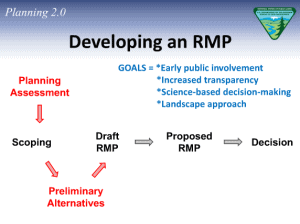Share this article
Flexibility the focus of BLM proposed planning revision
Landscape-scale planning, adaptability and public input are key components of the Bureau of Land Management’s proposed planning process update – the first major overhaul to their resource management planning regulations in 33 years.
The Federal Land Policy and Management Act (FLPMA) and subsequent regulations, require BLM to manage its public lands according to approved Resource Management Plans (RMP) based on the principles of multiple-use and sustained yield. The BLM, which manages habitat significant to the greater sage-grouse, among other species, relies heavily on these RMPs to guide management decisions. Traditionally, local and regional offices established RMPs through a four-stage process: scoping, draft RMP, proposed RMP and decision.
However, the process is “way too slow, and too expensive,” according to BLM Director Neil Kornze. At a House Congressional Appropriations hearing March 3, he said that the fix – which BLM calls Planning 2.0 – is counterintuitive, but brilliant.
“Let’s add a couple of extra steps into the process. Let’s start by raising our hand and saying ‘bring your best information and your best science to the table,’ so that we don’t get surprised by someone with information two-thirds down the road [and] have to start over – which we have to do a lot,” Kornze told the House Appropriations Subcommittee on Interior, Environment, and Related agencies.
Public Input
As Kornze suggested, the proposed changes in Planning 2.0 add a new first step, to precede scoping, called the “planning assessment.” This step explicitly calls for public input and coordination to gather information and assess baseline conditions.
As the regulations currently stand, the public can get involved between the draft and proposed RMP stages during a formal 90-day comment period. The proposed rule shortens that period to 60 days, owing to increased public involvement upfront.
After the proposed RMP is published, the public may submit formal protest for 30 days. The Planning 2.0 revisions alter guidelines for what qualifies as a valid protest. Protests would be required to identify plan components that are believed to be inconsistent with law, regulation or policy, as well as explain why.
Outcomes, not output
“In general, we are trying to focus…on desired outcomes, instead of desired output,” said Shasta Ferranto, Planning 2.0 Project Manager for BLM. Outcomes – goals and objectives – would provide a vision of what the planning area should look like, and what specific and measurable resource conditions would be used as indicators of success.
Several rule changes are being proposed to apply adaptive management and science-based decision making, including the addition of a “preliminary alternatives” stage to fall after scoping and before draft RMP. Plan components and rationales would be developed for each alternative, along with procedures, assumptions and indicators.
Additionally, proposed adjustments would allow planning areas to cross state boundaries. Under the proposed rules, the director determines the planning area as well as the deciding official for RMPs that cross existing jurisdiction borders.
“Plans need to be able to cross boundaries, or at least speak across boundaries,” Ferranto said, specifically calling out management of migratory species and invasive species. “Halting the spread of invasive species cannot be achieved without cooperation.”
Get involved
BLM is requesting comment on the proposed changes as a whole, and also specifically on whether environmental impact statement (EIS) amendments should follow National Environmental Policy Act procedures, with additional extra steps on a case-by-case basis, or whether they should follow the same procedures as preparing an RMP. An EIS is prepared concurrently with the RMP, and is subject to public scoping.
The final rule, which they aim to have published by the end of 2016, will summarize and respond to comments, integrating suggestions where appropriate. For more information on Planning 2.0, visit the BLM website or watch the webinar presentation.
The public comment period for the proposed changes to BLM’s planning regulations is open until April 25. Comments should be clear, and specific. The Conservation Affairs Network provides an example comment in the policy toolkit.
Header Image: ©Bob Wick, BLM









